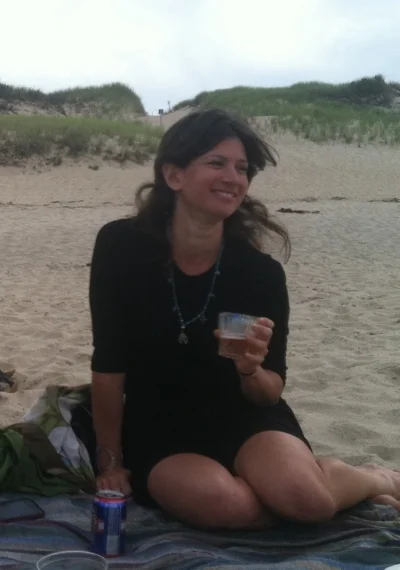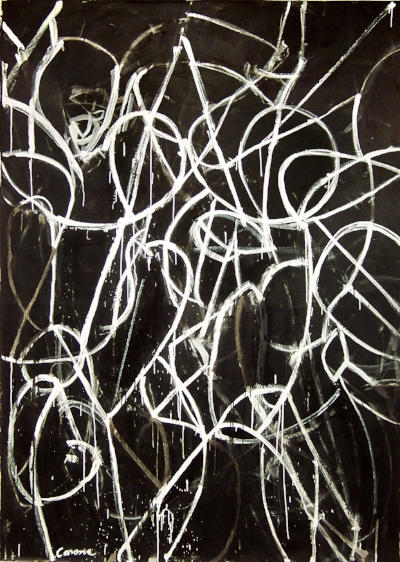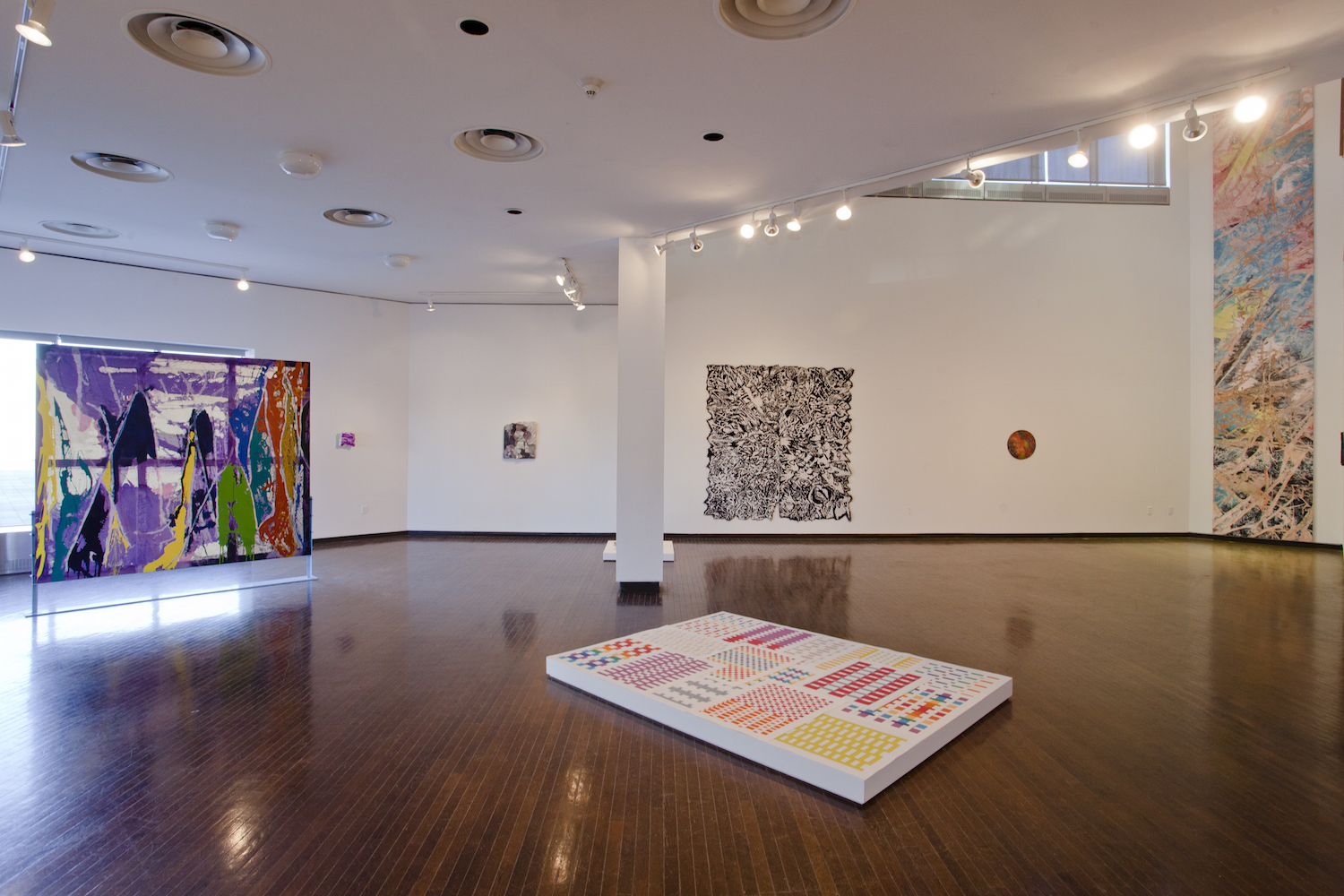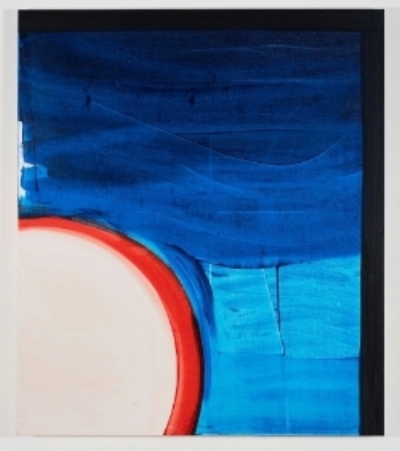Jennifer Samet is a New York-based art historian, curator, and writer. She teaches at the New York Studio School and The New School. She has lectured at universities across the country on the subject of “The Role of Empathy in Art” and “Slow Art.” She curated major historical exhibitions on Jane Street Group and the history of the New York Studio School; and thematic exhibitions such as “Rough Cut,” “Repetitive Motion,” and “Physical Painting.” She is the author of the column “Beer with a Painter,” in Hyperallergic Weekend Edition.
Jennifer Samet, in Truro, Massachusetts, for "Beer with a Painter" interview with Sharon Horvath.
Brett Wallace: What was your origin in art?
Jennifer Samet: I grew up in the New Jersey suburbs. I remember being conscious, even as a child, that there wasn’t a lot of culture around me. Culture was definitely part of my parents’ life. But outside of that, it wasn’t there. So I vividly remember the pleasure of going to New York, to the Metropolitan Museum with my mother, and looking at Pollock paintings.
There were art books in my house, and I remember a book about Karel Appel, and a box set of thin books. There was one about Cézanne in there. It was very digestible for a kid, because it only had about ten reproductions. My mother went to art school and she painted. She didn’t really paint professionally after I was born. But she had studied painting in Boston.
My parents took us to a lot of classical music – Carnegie Hall and special matinees at the Philharmonic that were family-friendly. We went to Tanglewood every summer and would listen to concerts and picnic on the lawn. So it was just this high culture. My parents only let me watch PBS and I was totally sheltered from popular culture. It was extreme!
BW: How would you describe your roles today?
JS: I always say that I work with art in a few different capacities. So I teach Art History and I write about art, and I’m also Co-Director of the gallery Steven Harvey Fine Art Projects.
BW: Could we talk about your Ph.D. dissertation (which seems very relevant to your focus on painting today)?
JS: It was called “Painterly Representation in New York: 1945 to 1975.” I wrote about a generation of painters, many of whom studied with abstract painters, in particular, Hans Hofmann. So they started out making abstract paintings, at the height of Abstract Expressionism, but they ended up becoming figurative or representational.
That was the generation I wrote about. It’s not really a group, per se. But a lot of them knew each other and were in conversation. It includes people like Mercedes Matter, who was, along with a group of her students, the founder of the New York Studio School; Robert de Niro, Sr.; and Louisa Matthiasdottir.
Photo: Nicolas Carone, In Orbit, 2007, Acrylic on canvas, 84 x 60 in., part of "The Space Between," curated by Jennifer Samet for the New York Studio School, February - March 2015
BW: And, did you find it interesting that abstraction originally came out of figuration (as in the case of Picasso deconstructing the image or De Kooning moving from the figure to abstraction)?
JS: Yes, abstraction was the zeitgeist, and considered the highest form of progress in art. It was the way to go. And there was an intellectual underpinning to all of it. Some of those artists, like Nell Blaine, for example, started out being very dogmatic about abstraction. So it’s an interesting shift, to then give up all of the polemical reasoning behind it and start painting flowers again. Sometimes, when things become too extreme, that is one reaction. Anything can become an academy.
This group came out of nonobjective art and Mondrian, and people from the Abstraction-Création group in France, like Jean Hélion. So, in part, they were coming out of the 1930s and 1940s abstraction movements. They also studied with Hofmann, of course, who was called the Father of Abstract Expressionism.
BW: Let’s talk about your own conversation series, Beer with a Painter. What’s your vision for this ongoing project?
JS: There’s always been a really specific vision to “Beer with a Painter.” Even though it has that playful title, it comes out of something serious. It’s that I believe that what I call “the voice of the artist” is becoming lost in art history. I think it’s an untold art history right now. This relates to my idea that when things become too extreme, they are problematic.
Art History right now, and this has been going on for at least fifty years, is focused on socio-political methodology, which is indeed important and valid. But when things become too extreme, you lose other things. I would say that you are losing sight of the fact that the artist is not just a product of his or her sociological and political context, but also an individual. And you’re not really looking at the work of art itself from any kind of formal, material perspective.
Art historians are looking at it more from a literary perspective. Art historians traditionally had a background in making art themselves, but increasingly they don’t. So they are often great at writing and understanding the context of the art. But, increasingly, what was known as “connoisseurship” – a big part of 19th Century art history – is no longer valued. I noticed this when I was working on my Ph.D.
After I finished it, I wanted to get back into that place where I was really listening to the “voice of the artist.” To me, this is two-fold. It’s the literal voice of the artist, and also listening to the work of art, as a visual object.
BW: Nicely said.
JS: So, that’s what “Beer with a Painter” came out of. It was also just about having fun with art again. Because I had lost that initial thing we were talking about from childhood. The pleasure aspect had slipped away, and it had become something else. Also, since I had always done interviews, a friend, the painter Ryan Cobourn, advised me, “You should make them more rambling, more informal. You should do them over beer.”
Then, the weird thing was that a year or two later, another friend, Kyle Staver, suggested I do interviews over beer, and call it “Beer with a Painter.” Once it was suggested by multiple people, I started it. The first one was with Matt Phillips; shortly after, was Sharon Horvath. Then it was picked up by Hyperallergic. I’m lucky that Hyperallergic, and my Weekend Edition editors, John Yau and Thomas Micchelli, have been so supportive, and given me a platform and a lot of creative control. It’s a gift.
Photo: Jennifer Samet with Mary Heilmann in her Bridgehampton studio for an interview, January 2013
BW: What are the dimensions by you define painter or painting by?
JS: I would say it is artists who are dedicated to the material and medium of painting. Maybe you are doing unconventional things with it (I curated a show about this, called “Physical Painting”), but there still is that focus on paint. We are still in a culture of “post-studio” work, so the studio work, and painting itself, is my focus in these interviews.
The reason that I have made it “Beer with a Painter,” as opposed to other artists is that I thought that contemporary painting wasn’t being given the attention, institutionally - within the museum world, and art historically. Painting is also the thing that I personally get the most excited about; I feel the most attached to; and I know more about painting than I do other media. So I have the most to offer other people when I’m writing about painting. Contemporary painting was the thing that I thought needed more attention from an art historical lens.
Photo: Installation of "Physical Painting," curated by Jennifer Samet in conversation with Scott Wolniak, for the Maass Gallery, Purchase College, February - March 2016
BW: How do you think new technologies have changed the audience for painting? I’m thinking about Paul Virilio’s controversial argument in The Accident of Art. Virilio and Hobsbawn raised the notion in that essay that Disney has surpassed Monet in the ability to reach the masses and create change in the world (Lotringer, Sylvelre, and Paul Virilion. The accident of Art. New York, NY: Semiotext(e), 2005. Print.)
JS: I’m aware that what I’m doing has a very specific and small audience within the context of our entire cultural production. This is a small world, the amount of people who really care about painting, the way that I do, and the way that all of the people I talk to do! I want my writing to be accessible, but at the same time, you still have to be a pretty interested reader, to read a 3,000-word interview with a painter - even if it’s with someone really well-known. So in that sense, I don’t think that painting can compete with pop music, in terms of the audience that it reaches. But I still think it’s really important, and I still have a lot of faith in it and belief in it.
I don’t care that Disney has more of an audience or that Kanye West has more of an audience. I don’t care. It doesn’t really matter, in terms of what I’m saying. Painting is still important. Even if there is a really small audience for an artist, it still may be important.
I think it touches a significant number of people. I think that artists have a lot of power, to influence culture, politics, the world, and the fabric of New York City, for example. I don’t go so far as to say that art alone can effect change, but I think artists make propositions, and I think painting can offer a new way of seeing. These are actually ideas that Angela Dufresne and Terry Winters discussed in our conversations.
It is distressing how many artists have been pushed out of our city - out of Manhattan and into the boroughs, and out of the boroughs, into other places. I think artists have a huge impact on the lives of all kinds of people, whether they realize it or not.
BW: Yeah. And, it is happening to galleries too. I was reading an article in Artnet today by Christian Viveros-Faune about the squeeze of mid-market galleries.
JS: It’s become really hard, and there are a lot of galleries closing right now. I wish the city were making more of an effort to subsidize and help artists and small galleries.
Andrea Belag, After Krushenick After Hokusai, 2016, oil on linen, 56 x 48 in., part of "Outside In," at Steven Harvey Fine Art Projects, December 2016
BW: What role can empathy can play in art?
JS: The talk that I gave about empathy in art came out of an idea of Hans Hofmann. I wrote a lot about Hofmann and his teaching, and specifically this book that he wrote and rewrote over a period of 40 years, and which still hasn’t been published, called “The Painter’s Primer.” There is a whole section in it about empathy. It is a philosophical idea that factored into the work of German art historians, such as Wilhelm Worringer.
That’s what I was speaking about, but I do think it has that broader implications for me, and how I write about art. Going back to my mother, she died when I was 13 years old. So in some way, I think all of the work that I’ve done has been devotional or dedicated to her. As I said, she stopped making painting when she had children. Not to be too grandiose, but I’ve always wanted part of my contribution to be about helping artists continue to make art, rather than stop.
So, in some sense, the interviews come out of that spirit. I don’t think of myself as an investigative reporter. I’m not trying to dig up dirt, although I do want them to be something the artist hasn’t said before. I want them to provide insight the audience has not already had into the work. But I want the artists to consider the interviews a statement they are happy to put into the world. The interviews are more about identification between two people, and having a conversation that’s real. I want them to read as an experience between two people, which they are.
I want them to be personal. When you have an open dialogue and bring that kind of openness, or as my friend, the archivist Jean-Noël Herlin calls it — “a generous eye” —to looking at art, it usually adds a lot of dimension to the work.
I don’t think you have to know all about an artist to love their work, or you have to love the person to love their work. But I think it adds a dimension. To go back to my “untold art history” idea — the artist is an individual, as well as a product of their time.
BW: How do you see established models of painting, such as the artist-as-hero, shifting to new models?
JS: Well, I think it’s complicated. The artist-as-hero archetype comes out of a very specific moment in time. In fact, some of my favorite moments in interviews I’ve done are when artists have talked about their work as not being about him or herself, but, rather, about something larger. Glenn Goldberg spoke about this, in our interview, and also Susan Walp, and others that I’m forgetting right now.
The artist Peter Acheson is such a smart person who I’ve gotten a lot of ideas from. He’s talked about the artist–as-hero archetype changing over time, so that now the predominant archetype is the artist-as-trickster. My interpretation is that in the days where existentialism was the reigning philosophy of art-making, every mark and move by the artist was considered important, and carried so much weight. But the artist can also be someone who actually disrupts society through more playful means. He is referring to the role of the trickster in a society. He or she does things to create disruption, effect change, and influence how people see. Acheson talked about how that archetype manifests aesthetically in the work.
For example, you were talking about smaller galleries. Nowadays, artists are doing a lot of very interesting projects in alternative spaces, exhibitions outdoors, projects in spaces where art “shouldn’t” be - lots of pop-up shows. And of course there is street art. I think of it as the artist-as-trickster, and I’m a big fan! I’m all for artists making things happen out of their own vision and energy, especially as a way to react to the increasing 1% nature of the art world: mega-galleries and museums focused on drawing bigger and bigger crowds. There is so much art buried in the basements of museums and in storage spaces, which never gets shown. Chris Martin talked about this in the interview we did.
Photo: Installation of "Rough Cut," curated by Jennifer Samet and Elizabeth Hazan for Morgan Lehman Gallery, January 2015
BW: What impact do you see social media having on artistic practice?
JS: I think our social media culture has a big impact on people’s art, whether they’re using actual visual images sourced from the Internet, or their aesthetics are affected by the Internet and social media. It manifests aesthetically as a fracturing of forms, or work that has overlays, a multiplicity of images and elements crowded together. It reflects our culture where we are subject to image overload, a constant, overwhelming stream of visual information. I think almost any artist that I could name is somehow drawing on that, or using social media as an important mode of communication.
BW: There’s also some artists who look at their work as a resting place away from the digital saturation.
JS: Definitely, yes. Well, another lecture that I’ve given is titled “Slow Art: Looking at Painting in a Culture of Distraction.” It’s about how we are used to looking at things really quickly. We have to move really quickly, and we are always multi-tasking, visually and otherwise. Even when we watch a movie, we tend to be doing two other visual things at the same time. I feel like I rarely have the kind of experience I used to, where I would go to a movie theater, or screen a movie at home, and only watch that. It is much more common that we’re watching television on our laptop, and looking at our phones and checking social media and email simultaneously.
You were asking about the audience. There’s a reason that painting is hard to look at, and it’s because it takes time and concentration. You have to give it a different kind of attention. I think that’s why there is a relatively small audience for it. Who really has the patience?! Even for us, the people who work in the art world, make objects, or write about them, it still can be hard.
I still tell myself to put away my phone, while I’m in a museum, because otherwise, I won’t really look in the way I want to. It’s hard for very seasoned people who love painting.
Photo: Installation of "Repetitive Motion," curated by Jennifer Samet for SHFAP at Projector Gallery, March - April 2014
BW: Could we talk about the importance of this upcoming show you co-curated with Michael David at David & Schweitzer Contemporary?
JS: Yes. I know that sometimes, when there is a dramatic political moment, like we are experiencing right now, there can be a feeling that art-making doesn’t matter as much as actions like calling on your Congress people, which obviously is really important right now. But I think that art is important, too.
So, for myself, right after the Election, I was looking at social media and still going out to look at art. I found it comforting to look at images and work by women artists who were dealing with the body. Because, for me, and for a lot of people, a very big disappointment was that our country elected someone who bragged about sexual assault. People basically said that was okay, they would vote for him anyway.
It was like making women’s issues, and women’s bodies, invisible and unimportant. So, right after the election, in just the week that followed, I knew, even subconsciously, that looking at body-based imagery by women was giving me comfort. It felt important to be looking at it, and I was really grateful that it was out there for me.
I had also gone to this protest in October that was called “Pussy Power at Trump Tower.” And it was a really wonderful moment, in the whole election process, where I felt like good, old-fashioned feminist rage and power was back in the world.
It was the same night as the third debate, and Hillary answered a question about Roe v. Wade. She gave a powerful statement about choice and the mother, and the health decisions of the woman being of ultimate importance. It felt like a big moment. She was strong and unapologetic. She wasn’t pulling any punches. I loved listening to her that night. So the idea for the show came out of those things.
Also, Michael David and I had already been talking about collaborating on a project, which was related to women artists and the body, somehow. So, I wrote to him and said, “What do you think about doing a show called ‘#PUSSYPOWER’?” And he immediately responded, “Yes.” There was no hesitation. He was on board. We started putting it together immediately.
It’s a really big show – with over 40 artists. It includes pioneer feminist artists, such as Carolee Schneemann and Hannah Wilke, next to younger artists, such as Giordanne Salley. We are trying to show a range of artists who are dealing with the body and feminism right now. I tried to include some of the artist-activists who were important to me pre-Election Day.
Photo: Jane Dickson, East Village Eye Centerfold 3, 1982, Monoprint with ink on rice paper, 9 x 13 in., part of "#PUSSYPOWER" exhibition at DAVID&SCHWEITZER Contemporary, December 2016-January 2017
BW: Yes, people having a voice and thinking and acting beyond the studio walls.
JS: Yes. Wendy White, for example, is someone who had a really interesting project. She was cataloguing and posting on Facebook all the examples of misogynist statements and rhetoric that were happening during the campaign. I thought that was really important, a great project.
BW: And, this past weekend, there was the “Dear Ivanka” march.
JS: Yes, it’s been the critics and the curators, too. The “Dear Ivanka” protest was organized by curator Alison Gingeras. Walter Robinson is an example of an artist-critic who was posting all throughout the campaign and primaries in support of Hillary. Jerry Saltz has been an important voice. After the election, he was telling artists to use the anger and energy in their studio, and telling people to continue to go out and look at art. His words also became a motivator for the show. Saltz, in fact, I think, utilizes the critic-as-trickster model; he uses provocative methods to get attention for his writing. People say it’s narcissistic or just to get attention for himself. But I don’t think so. I think he is quite aware that it is bigger than himself.
BW: Jen, what’s in store for you in 2017? What are you most hopeful about?
JS: Well, honestly, it’s a tough time to be super hopeful. I’m hoping we all survive the Trump era. But I have exciting exhibitions I’ve started to work on for Steven Harvey Fine Art Projects, like a show of the Texas-based painter Sedrick Huckaby. And I’m grateful that I spend a good portion of my life looking at and thinking about painting. It is endlessly engaging to me.







